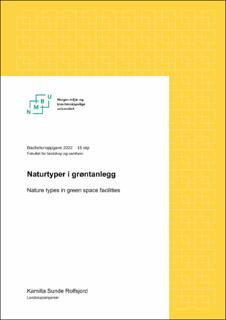| dc.contributor.advisor | Strøm, Kathrine Omnia | |
| dc.contributor.author | Rolfsjord, Kamilla Sunde | |
| dc.coverage.spatial | Norway | en_US |
| dc.date.accessioned | 2022-11-01T07:44:07Z | |
| dc.date.available | 2022-11-01T07:44:07Z | |
| dc.date.issued | 2022 | |
| dc.identifier.uri | https://hdl.handle.net/11250/3029231 | |
| dc.description.abstract | Norsk natur er under press. 123 naturtyper er oppført på norsk rødliste for naturtyper og står i fare for å bli utryddet. De største årsakene til at naturtypene er truet er arealendringer fra utbygging og landbruk, kolonisering av fremmede arter og klimaendringer. Miljødirektoratet er i ferd med å kartlegge verdifull norsk natur gjennom «Miljødirektoratets kartleggingsinstruks» og systemet «NiN 2» (Natur i Norge). Som forvaltere og planleggere har vi et særskilt ansvar for å ta vare på truede naturtyper. Jeg vil i denne oppgaven se på hvorfor det er viktig å ta vare på og opprette viktige naturtyper i grøntanlegg og noen metoder for planlegging og prosjekteringsprosess som er brukt i lignende prosjekter i Norge. Jeg vil også se nærmere på karttjenestene «naturbase», «økologiske grunnkart», «Miljødirektoratets kartleggingsinstruks» og «NiN 2» og deres beskrivelse av naturtypene. Er disse egnet å bruke som verktøy i planleggings og prosjekteringsfasen av et prosjekt?
Som eksempelstudie bruker jeg caset «Museumsutstikkeren», et prosjekt hvor de førsøker å anlegge en kalkrik tørreng, inspirert av naturtypene på Hovedøya. Vi ser hvordan de bruker lignende prinsipper og metoder som den fra restaureringsøkologien. De prøver å konstruere noe som ligner en naturtype, men tilgang på plantemateriale og råstoffer til jord, samt en del uheldige hendelser skaper noen begrensninger. | en_US |
| dc.description.abstract | Norwegian nature is under pressure. 123 nature types are listed on the Norwegian list of endangered nature types. The main reasons that they are endangered are area changes as a result from development and agriculture, colonization of foreign species and climate changes. The Norwegian Environment Agency is in the process of mapping valuable nature through the manual “Miljødirektoratets kartleggingsinstruks” and the system “NiN 2” (Nature in Norway). Managing and planning for development of green areas, gives us a special responsibility to preserve endangered ecosystem types.
In this thesis I will look into why it is important to preserve and, in some cases, construct ecosystem types in green space facilities. I will also go through some methods for planning and engineering that are used in similar projects in Norway. I will take a closer look into the manuals and tools from The Norwegian Environment Agency, to see if they are appropriate tools for the planning and engineering process.
As an example, I will use the case “Museumsutstikkeren”, a project where they try to construct a calcareous meadow on a concrete construction. Here we see how they use similar methods as in the planning and engineering phase of ecological restoration projects. They try to make something like an ecosystem type, but they meet some challenges in the access of plant materials, soil components and knowledge. | en_US |
| dc.language.iso | nob | en_US |
| dc.publisher | Norwegian University of Life Sciences, Ås | en_US |
| dc.rights | Attribution-NonCommercial-NoDerivatives 4.0 Internasjonal | * |
| dc.rights.uri | http://creativecommons.org/licenses/by-nc-nd/4.0/deed.no | * |
| dc.title | Naturtyper i grøntanlegg | en_US |
| dc.title.alternative | Nature types in green space facilities | en_US |
| dc.type | Bachelor thesis | en_US |
| dc.description.localcode | B-LI | en_US |

